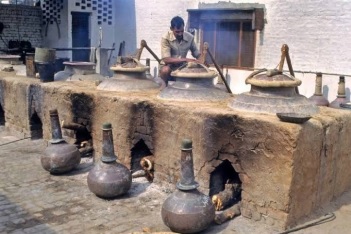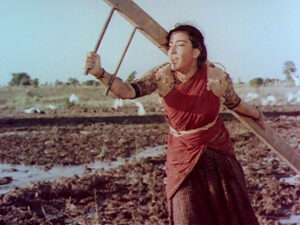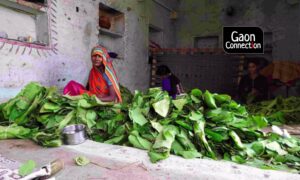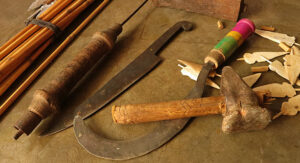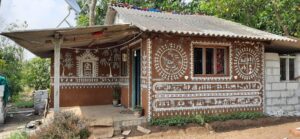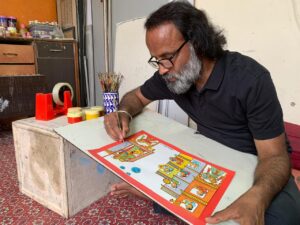A good fragrance is really a powerful cocktail of memories and emotion. Jeffrey Stepakoff, The Orchard
The word ‘Attar’ or ‘Ittar’ comes from an ancient Persian word ‘attar’, ‘otto’ or ‘ottar’, that means perfume, fragrance or scent. Manufacturing of Attar fragrance oils is the practice of extracting scent from flowers, herbs and other botanical sources. Some attar oils are extracted from wood species as well. It is commonly known as Ittar as well in India.
The history of fragrance
Attar is quite ancient in India; it’s more than 60,000 years old. We find mentions of fragrance and perfume in the olden Indian epics and Granths. The kings would begin their day with fragrance. According to ‘Agni Purana’, they would take bath with over 150 varieties of fragrances. The consumption of fragrances was enormous in the harems of kings. As a large number of men and women were engaged in preparing fragrances amongst whom the woman numbered the most. These women were called Gandhkarika or Gandhhadika. These fragrances were known as Itra.
The earliest record of perfume-making in India can be found in the ‘Bri- hat Samhita’, an encyclopaedia authored by the philosopher Varahamihi- ra – a 6th-century Indian astronomer, mathematician, and an astrologer who lived in Ujjain.
The Egyptians were famous for producing perfumes
In the world history, the Egyptians were famous for producing perfumes throughout the ancient world. They were formulated from plants and flowers before they could be added to other oils. It was later refined and developed by Al-Shaykh al-Rais, a renowned physician who made a distinctive type of aromatic product. He was referred to as Abi Ali al Sina. He was among the first people to come with the technique of distillation of roses and other plant fragrances. Liquid perfumes used to be a mixture of oil and crushed herbs until his discovery where he first experimented with roses. His popularity spread over other continents after he created rose water which was more delicate than the previous versions. He formulated at least 62 cardiac medicines out of which 40 were made from ittar. They include Attar of Oud, Attar of Roses, Attar of Saffron and Attar of Jasmine.
In Yemen, a special variety of Attar was introduced by Arwa al-Sulayhi, the Yemeni Queen. This type of Attar was prepared from mountainous flowers and given as a gift to the monarchs of Arabia. Attar is commonly used within Muslim communities and amongst natives of the Indian Subcontinent and Arabia to treat numerous health disorders, and it was widely used in Greek medicine.
Most of the Mughal emperors and their queens were fond of attar
There are many sources which cite that use of attar oils and fragrances added a nice whiff to life during the Moghul times in India. Most of the Mughal emperors and their queens were fond of attar fragrances and this led to the discovery and development of attars in India. Court historian Abu’l-Fazl ibn Mubarak chronicled Mughal emperor Akbar’s regular usage of attar and incense sticks in the Ain-e-Akbari (Constitution of Akbar) – a 16th-century detailed document. According to historians, the popular Mughal emperor Akbar had a whole department of perfumery so that he and his successors could keep their bodies (and minds) well scented in a region where the hot climate could be countered effectively.
There are several stories about the origin of attar, including one involving Mughal emperor Jahangir, who is credited as the first patron of the industry because his wife, empress Noor Jahan was a connoisseur of itra and used to bathe in water perfumed with rose petals. Soon people began experimenting with natural scents, with the encouragement of Jahangir, leading to a culture of attar-making that continues to this day.
According to some sources, the process of development of attar from roses was discovered by then Mugal queen Noorjahan. However, historical researchers say that it was indeed the discovery of her mother Asmat Begum, who is from Persia.
The ruler of Awadh, Ghazi-ud-Din Haidar Shah used to prepare fountains of Attar around his bedroom. These fountains would create a very pleasant fragrant and romantic atmosphere by functioning continuously.
Jasmine Ittar was the favourite perfume of the Nizams of the Hyderabad state. The fondness for itra during Mughal periods reached its acme; the Mughal had settled the Gandhies (experts in making itras) sanctioned them Zamindaries and let them make the different varieties of itras. Even to this day, the rose cultivation in a massive scale is going on in the Malwa borders of Rajasthan from where different species of beauteous roses are exported to the foreign countries and within the union territories.
Awadh promoted the cultivation and Itar craftsmanship
Some of the first fans of the oils were the Mughal nobles of India. After the decline of the Mughal dynasty in the 18th century, the Nawabs governed Awadh and became its rulers. That the late Nawab, Wajid Ali Shah, was a kathak dancer. The arts and crafts scene had flourished in Lucknow, the capital of India’s Awadh province during the Nawab era. It is said he sweated a lot during his dance practice, so he would wear the henna attar. And Awadh promoted the cultivation and Itar craftsmanship, which continued till date.
Kannauj perfume has a long historical background
The history of attars is very much associated to the history of Kannauj, a small town in Uttar Pradesh in India. This town connects to legacy of Itra from ancient time to till date through Mughal period and Awadh Riyasa. Kannauj perfume has a long historical background and Kannauj had perfume trading for thousands of years. Due to the key role of perfume production in Kannauj, the city is known as “the perfume capital of India” and “Kannauj is to India what Grasse is to France”. An expert in the region says: “Kannauj has been the perfumery town of the country for thousands of years”.
Organic attars were explored during the Mugal period
The city has been known for natural attars even before Mugal time when aromatic botanicals such as Sandal, Musk, Rose, Camphor, Saffron etc were used to extract natural fragrances. These natural organic attars were further explored and experimented during the Mugal period India. Kannauj Itty has been protected under the Geographical indication (GI) of the Agreement on Trade-Related Aspects of Intellectual Property Rights (TRIPS) agreement. It is listed at item 157 as “Kannauj Perfume” of the GI Act 1999 of the Government of India with registration confirmed by the Controller General of Patents Designs and Trademarks.
Ittar in Ittardan as Tradition
Traditionally in the Eastern world, it was a customary practice of nobility to offer ittar to their guests at the time of their departure. The iterates are traditionally given in ornate tiny crystal cut bottles called as itardans. This tradition of giving a scent to one’s guests continues to this day in many parts of the Eastern world. Among Sufi worshipers, the use of Ittars during meditation circles and dances is quite common.
Traditional Way of Attar Making
Traditional ways of making Attar & essential oils still thrive in Kannauj and are fondly preserved by craftsman and attar manufacturers/producers. This tradition has been passed on from generation to generation. The production of attar oils for floral is usually performed in remote areas as flowers are required to be processed at the earliest after they are plucked away from plants.
The apparatus and equipment used for producing various types of attar oils are light and efficient. The combination of equipment that are typically used for traditional attar making are:
Traditional deg or still: The process is carried out in copper stills, which are also referred as degs. From centuries degs have played a critical role in producing organic fragrance oils using traditional ways. Degs are made of copper metal and have an opening for connections to one or two receivers.
Bhapka or Receiver: The Bhapka, also called “receiver” is built of copper and contains round shape with a long neck. During the process of making attar the receiver is required to be connected with deg via chonga. It is popular as Bhapka in local language and it acts as condenser as well.
Traditional Bhatti or Furnace: Traditional bhatti that are used by attar craftsman is built up of bricks and clay. Typically, wood or coal is used for heating during the process.
Gachchi or cooling water tank: A cooling water tank is the place where Bhapka, or receiver is kept and its purpose is to cooling the distillate from deg.
Kuppi or leather bottle: Kuppi are the bottle made from leather of animals. These bottles are used to remove moisture from attars.
Classification of Ittar
Ittars are generally classified based on their perceived effect on the body. ‘Warm’ ittars such as musk, amber and kesar (saffron) are used in winter, as they are believed to increase body temperature. Likewise, ‘cool‘ ittars such as rose, jasmine, khus, kewda and mogra are used in summers for their perceived cooling effect on the body.
Qualities of main Ittars
Natural musk is commonly mixed with medicines and confectionery. Purported medicinal benefits range from working as an antivenom and strengthening organs. Oud has been traded and cherished among perfumers, healers, alchemists and oil traders. Some of the claimed medicinal uses include pain reduction and stress relief. Sandalwood oil is popularly used in incense for its reputed calming effect during meditation. Rose oils are obtained by steam-distilling the crushed petals of roses, a by-product of which is rose water. Rose oil has been used since ancient times in ittars, as well as within emollients and as an anti-inflammatory agent. Jasmine oil, derived from Jasmine flowers, has a potent floral aroma and is a popular expensive ingredient in perfumes.
Mitti attar is the most special of them all, evoking the scent of the earth, specifically petrichor — the fragrance of first rain on parched earth. It is a scent that evokes memories of rain-laden grey skies, cool fertile mud and washed khullads or clay cups ready to hold steaming chai. Publishing in the journal Nature in 1964, Bear and Thomas proposed a name for the scent brought on by rain. They called it “petrichor,” a blend of the Greek words petra, rock, and ikhor, the blood of the gods in Greek mythology. But the scientists acknowledged that they were not the first to identify the stormy smell. They were not even the first to extract it. In fact, what they had dubbed petrichor was already a signature fragrance produced in Kannauj. Extracted from parched clay and distilled with ancient techniques, it is known as mitti attar — Earth’s perfume.
How to apply Attar
The recommended way to experience the fragrance of attar is to apply it to the inside of each wrist and dab a little behind each earlobe with the inside of your wrists before it dries. The attar will dry down in a few minutes after which you will experience its charming scent.
Ittar Beyond Words
For thousands of years, ittars were considered in some societies to be something that attracted angels and warded off evil spirits. Saints and spiritual aspirants would adorn themselves with these scents to assist them in their journey towards enlightenment. The different sects of Hinduism worship deities through household and temple offerings. Ittars are commonly used within the incense and food used as offerings. This is an age-old natural gift to mankind by nature. Hope next time when you sense fragrance, it will be much more than just an aroma, it will be more pleasant as a natural gift with a pinch of history and science with art and tales.
Harsh Pathak is a lawyer by profession and an amateur connoisseur of natural, historical and cultural heritage of Delhi.

